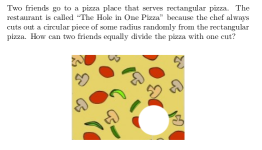lpetrich
Contributor
For the stereographic projection, a geodesic circle with offset c will have a radius related to it.
Spherical: radius = sqrt(c2 + 1)
Hyperbolic: radius = sqrt(c2 - 1)
In both cases, going through the origin is a degenerate case resulting from c going to infinity.
In the spherical case, nondegenerate geodesics surround the origin.
In the hyperbolic case, nondegenerate geodesics do not surround the origin, and their centers are outside the projection's boundary circle. At the boundary-circle intersections, the geodesics' tangent direction is the radial direction.
That means that two different geodesics that intersect on the boundary circle will have zero angle between them. That intersection is sometimes called an "ideal point". A polygon with ideal points as its vertices will have total angle sum equal to zero.
The area of a hyperbolic-plane polygon is much like the area of a spherical polygon.
Spherical: (sum of angles) - (n-2)*pi
Hyp plane: (n-2)*pi - (sum of angles)
Thus, an ideal polygon, a polygon with all its vertices ideal points, has area (n-2)*pi. An ideal triangle thus has area pi -- and all ideal triangles are congruent. One can tilt and rotate any one to get any other one.
On the sphere side, a polygon can be a biangle, a lune, with the vertices at each others' antipodes.
Note on terminology:
Stereographic projection of the hyperbolic plane = Poincaré disk model
Gnomonic projection of the hyperbolic plane = Beltrami–Klein model or Cayley–Klein model or Klein disk model
Hyperboloid surface = hyperboloid model or Minkowski model or Lorentz model
Poincaré half-plane = a conformal mapping of the Poincaré disk model:
zdisk = (zhfpl - i)/(zhfpl + i)
zhfpl = i*(1 + zdisk)/(1 - zdisk)
The z's are from rectangular coordinates: z = x + i*y
Spherical: radius = sqrt(c2 + 1)
Hyperbolic: radius = sqrt(c2 - 1)
In both cases, going through the origin is a degenerate case resulting from c going to infinity.
In the spherical case, nondegenerate geodesics surround the origin.
In the hyperbolic case, nondegenerate geodesics do not surround the origin, and their centers are outside the projection's boundary circle. At the boundary-circle intersections, the geodesics' tangent direction is the radial direction.
That means that two different geodesics that intersect on the boundary circle will have zero angle between them. That intersection is sometimes called an "ideal point". A polygon with ideal points as its vertices will have total angle sum equal to zero.
The area of a hyperbolic-plane polygon is much like the area of a spherical polygon.
Spherical: (sum of angles) - (n-2)*pi
Hyp plane: (n-2)*pi - (sum of angles)
Thus, an ideal polygon, a polygon with all its vertices ideal points, has area (n-2)*pi. An ideal triangle thus has area pi -- and all ideal triangles are congruent. One can tilt and rotate any one to get any other one.
On the sphere side, a polygon can be a biangle, a lune, with the vertices at each others' antipodes.
Note on terminology:
Stereographic projection of the hyperbolic plane = Poincaré disk model
Gnomonic projection of the hyperbolic plane = Beltrami–Klein model or Cayley–Klein model or Klein disk model
Hyperboloid surface = hyperboloid model or Minkowski model or Lorentz model
Poincaré half-plane = a conformal mapping of the Poincaré disk model:
zdisk = (zhfpl - i)/(zhfpl + i)
zhfpl = i*(1 + zdisk)/(1 - zdisk)
The z's are from rectangular coordinates: z = x + i*y

